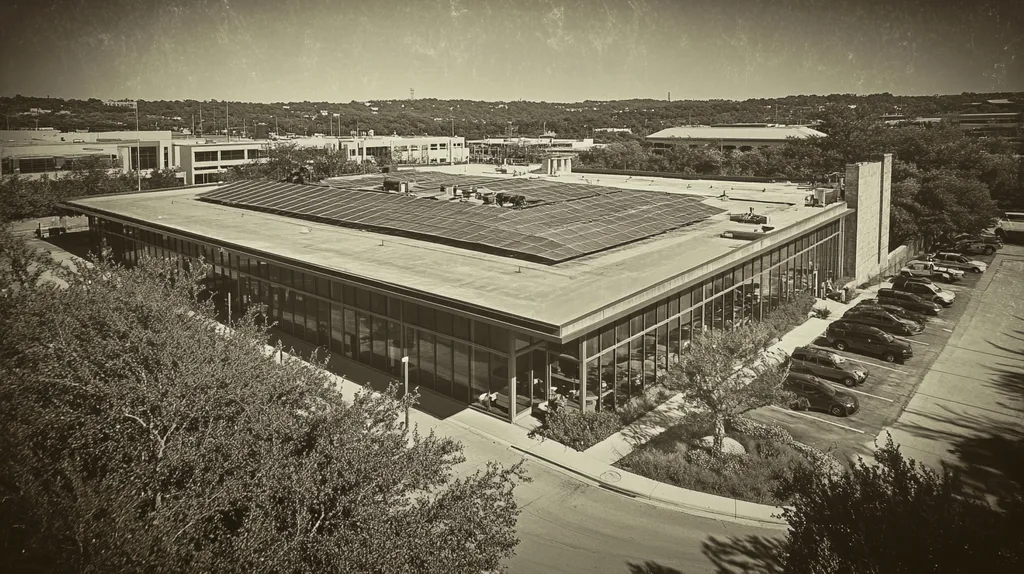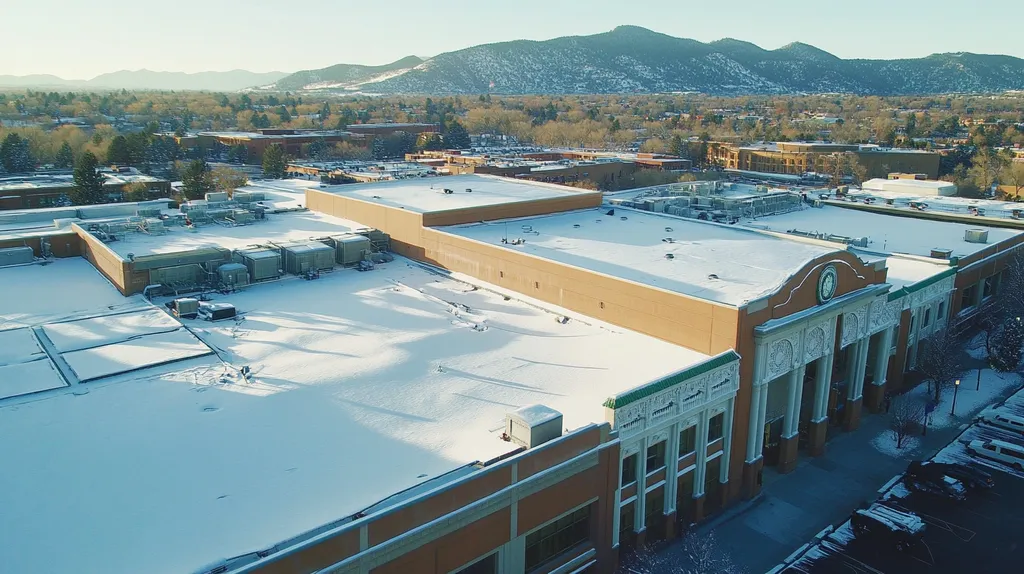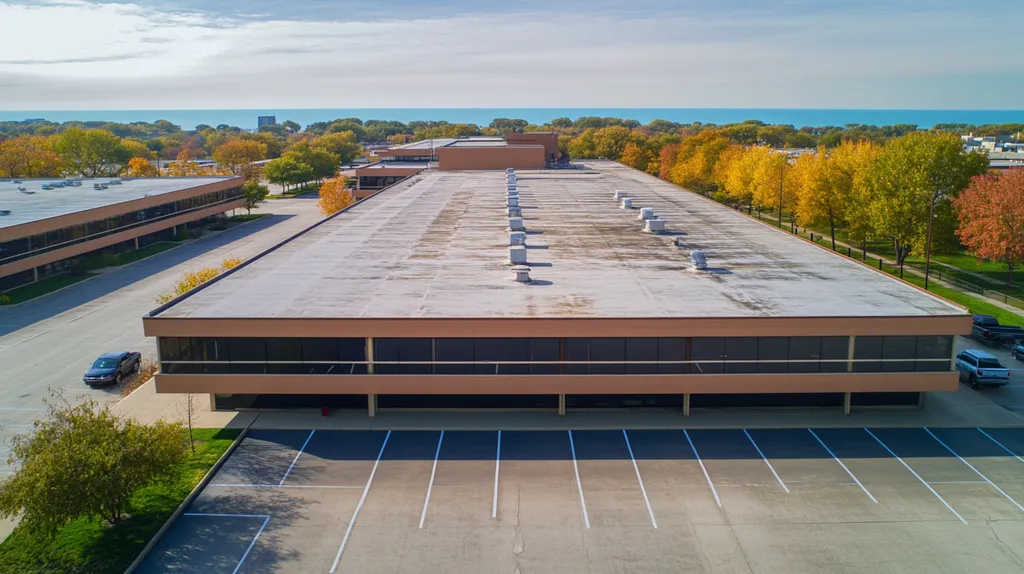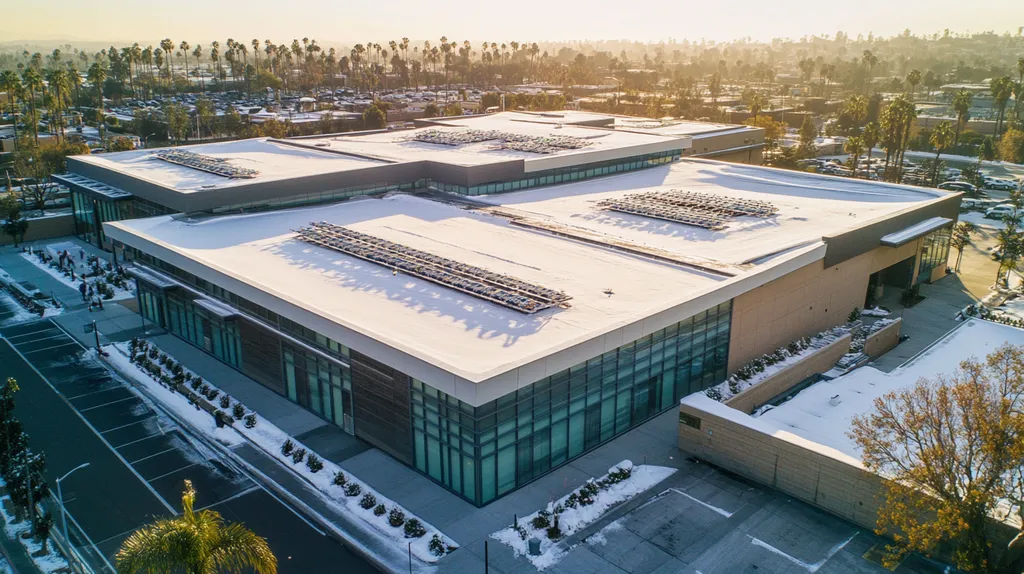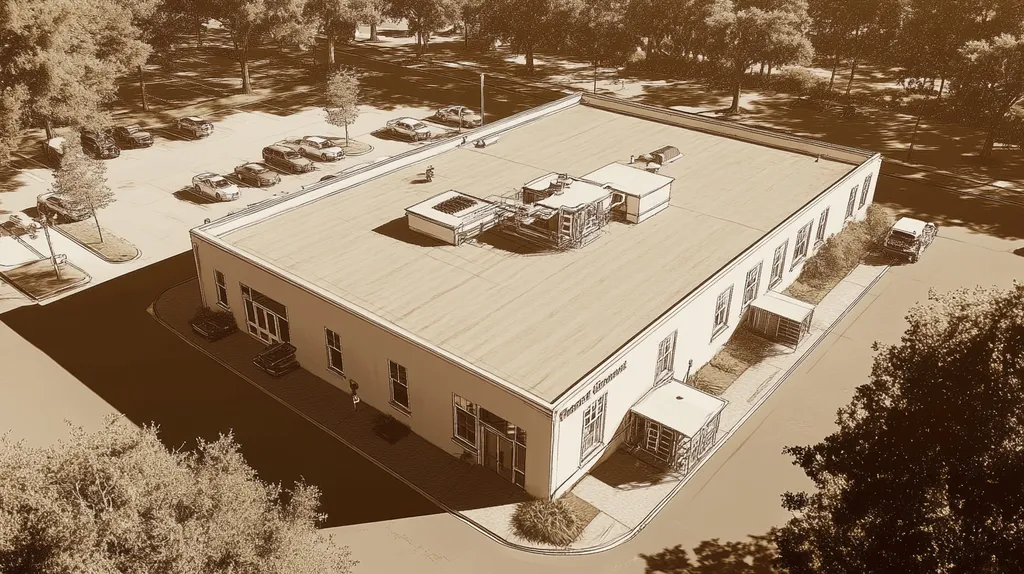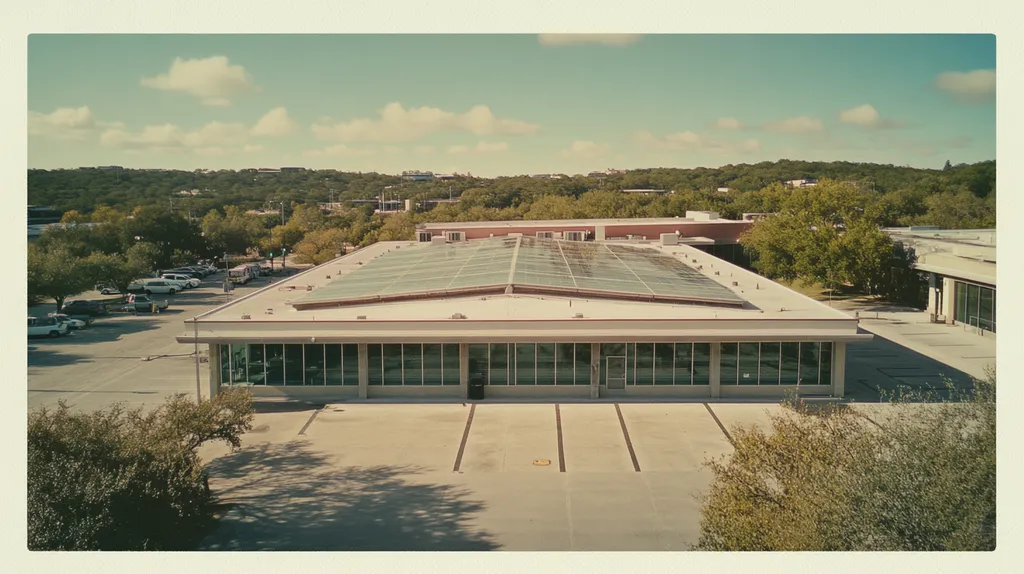From the asphalt-based systems of the 1950s to today’s high-performance synthetics, industrial roof coatings have undergone a remarkable transformation. Yet statistics show that 75% of coating failures still stem from improper material selection and application methods.
For facility managers overseeing buildings worth millions, choosing the wrong coating system can lead to catastrophic leaks, equipment damage, and operational shutdowns.
This comprehensive guide examines the critical components of modern roof coating systems, from substrate preparation to long-term maintenance, providing actionable insights for protecting valuable industrial assets.
SECTION 1: FUNDAMENTAL CONCEPTS
The evolution of industrial roof coatings reflects decades of technological advancement, yet many facilities still rely on outdated application methods that compromise safety and performance. Today’s coating systems can extend roof life by 15-20 years while reducing energy costs by up to 35% – but only when properly selected and applied. Understanding these fundamental concepts isn’t just about maintenance; it’s about protecting million-dollar assets and the operations they shelter.
Introduction to Roof Coatings
The days of basic tar and gravel systems have given way to sophisticated coating technologies that serve multiple functions. Modern coatings not only waterproof but also reflect UV rays, resist chemical exposure, and provide thermal regulation.
Coating selection must account for regional climate patterns, building use, and existing roof conditions. A warehouse in Arizona faces different challenges than a manufacturing facility in Maine, requiring distinct coating solutions.
Energy efficiency has become a driving factor in coating selection. Cool roof coatings can reduce peak cooling demands by 15-25% in single-story buildings, translating to substantial operational savings.
These systems also play a crucial role in sustainable building practices. Many modern coatings contribute to LEED certification points and help facilities meet increasingly stringent environmental standards.
Understanding Roof Substrates
The substrate – your roof’s underlying structure – determines coating compatibility and performance. Time has shown that 80% of coating failures stem from improper substrate preparation or material incompatibility.
Metal substrates require particular attention to surface preparation. Even minimal corrosion can compromise coating adhesion, leading to premature failure and expensive repairs.
Concrete substrates present unique challenges related to moisture content and pH levels. These factors must be tested and addressed before any coating application to ensure long-term performance.
Built-up roofing (BUR) systems, once the industry standard, require specific coating formulations to address their porous nature and tendency to develop blisters.
Single-ply membrane substrates demand careful evaluation of seam conditions and existing repairs. Coating these surfaces requires specialized primers and application techniques.
VOC Regulations Overview
OSHA mandates comprehensive fire protection programs for roofing operations, including specific requirements for handling flammable coating materials. This includes maintaining proper firefighting equipment and ensuring worker safety through appropriate protective gear.
Modern low-VOC coatings have transformed from being merely compliant alternatives to becoming performance leaders. These formulations often demonstrate superior durability while meeting stringent environmental standards.
Regional VOC regulations continue to evolve, with some jurisdictions adopting stricter limits than federal standards. Facility managers must stay informed about local requirements to avoid costly compliance issues.
Safety considerations extend beyond immediate application hazards. Proper ventilation, personal protective equipment, and worker training are essential components of a compliant coating operation. (source: OSHA)
Documentation of VOC compliance has become as crucial as performance testing. Maintaining proper records helps protect against regulatory scrutiny and supports environmental certification programs.
SECTION 2: SYSTEM COMPONENTS
Industrial roof coating systems represent a complex interplay of materials that must work in harmony to protect valuable assets. When even one component fails, the consequences can cascade through an entire facility – from damaged inventory to disrupted operations. Today’s coating systems have evolved beyond simple waterproofing to become integral parts of building performance, energy efficiency, and regulatory compliance. Understanding these components is crucial for making informed decisions that protect both facilities and bottom lines.
Types of Roof Coatings
Modern coating technologies have revolutionized how we approach industrial roof protection. Each coating type offers distinct advantages, from acrylic’s excellent UV resistance to polyurethane’s superior durability and chemical resistance.
Silicone coatings excel in extreme temperature variations and offer superior waterproofing capabilities. These coatings maintain their flexibility even after years of UV exposure, making them ideal for facilities in harsh climates.
Modified bitumen and elastomeric coatings provide excellent elongation properties, crucial for buildings that experience significant thermal movement. Their ability to expand and contract helps prevent cracking and separation at seams.
Cool roof coatings deserve special consideration for their energy-saving potential. These reflective surfaces can reduce peak cooling demand by 15-25%, offering substantial returns on investment through reduced HVAC costs.
Reinforcing Materials and Sealants
The role of reinforcement materials extends far beyond simple structural support. Polyester fabrics and fiberglass meshes create an interconnected matrix that strengthens the entire coating system, particularly at stress points and transitions.
Proper seam reinforcement can prevent up to 90% of common roof failures. Strategic placement of reinforcing materials at joints, flashings, and penetrations creates a robust defense against water intrusion.
Modern sealants have evolved to provide chemical resistance and UV stability while maintaining flexibility. These advanced formulations ensure watertight seals even under extreme temperature fluctuations.
Integrating compatible reinforcing materials with appropriate sealants creates a synergistic system that significantly extends roof life. This combination approach provides superior protection compared to either component alone.
Compatible Primers and Cleaners
Surface preparation represents the foundation of any successful coating application. Industrial facilities face unique challenges from airborne pollutants, chemical exposure, and environmental contaminants that must be addressed before coating.
The Occupational Safety and Health Administration emphasizes proper protective equipment when handling industrial cleaning materials and primers. Workers must use appropriate PPE including gloves, eye protection, and protective clothing to ensure safe application. (source: OSHA)
Specialized primers create chemical bonds between substrate and coating, dramatically improving adhesion. Different substrates require specific primer formulations – what works for metal may fail on concrete.
Advanced cleaning technologies now include eco-friendly options that effectively remove contaminants without harsh chemicals. These solutions maintain worker safety while ensuring optimal surface preparation.
SECTION 3: IMPLEMENTATION METHODS
The evolution from simple tar applications to today’s advanced coating systems mirrors the increasing complexity of implementation requirements. While modern materials offer superior protection, their effectiveness hinges entirely on proper installation methods. Industry data reveals that 85% of premature coating failures stem from improper implementation rather than material defects. Understanding and executing correct methods isn’t just about following procedures – it’s about protecting massive investments in facilities and operations.
Surface Preparation Techniques
The days of basic sweep-and-coat applications have given way to sophisticated preparation protocols that directly impact coating longevity. Modern industrial environments present unique contamination challenges that require specific cleaning approaches.
ASTM International standards specify precise surface preparation requirements for different substrate types and coating systems. These requirements ensure proper adhesion and long-term performance across varying environmental conditions. (source: ASTM International)
Moisture testing has become increasingly critical, particularly with newer coating technologies. Even slight variations in substrate moisture content can compromise adhesion and lead to premature failure.
Surface profiling requirements have evolved alongside coating technologies. Modern systems often require specific surface roughness measurements to achieve optimal chemical and mechanical bonding.
The introduction of digital moisture meters and surface profile gauges has transformed quality control in preparation phases. These tools provide quantifiable data to verify preparation meets manufacturer specifications.
Application Methods and Tools
Application technology has progressed from simple roller methods to sophisticated spray systems that ensure consistent mil thickness. These advancements allow for more precise control over material usage and coverage rates.
Temperature monitoring during application has become increasingly crucial. Modern coatings often require specific substrate and ambient temperature ranges to achieve proper curing and adhesion.
Digital thickness gauges now provide real-time feedback during application. This technology helps ensure consistent coverage and proper material usage across large industrial surfaces.
The integration of GPS mapping for coating application has revolutionized quality control. These systems track coverage patterns and help eliminate missed areas in large industrial applications.
Modern spray equipment includes built-in monitoring systems that track pressure, temperature, and mix ratios. These safeguards help prevent application errors that could compromise coating performance.
Safety Precautions and PPE
Safety protocols have evolved significantly from the basic protection measures of past decades. Modern coating applications require comprehensive safety systems that address chemical exposure, fall protection, and environmental concerns.
Air quality monitoring has become standard practice during indoor applications. Real-time monitoring helps ensure worker safety and compliance with increasingly strict exposure limits.
Fall protection systems now integrate with coating application equipment. Modern safety harnesses and anchor points are designed to allow full mobility while maintaining constant protection.
The development of specialized PPE for different coating types reflects growing understanding of material-specific hazards. Protection requirements now vary based on coating chemistry and application methods.
Emergency response protocols have become more sophisticated, incorporating specific procedures for different coating materials. These protocols include detailed spill response procedures and first aid requirements.
SECTION 4: MAINTENANCE REQUIREMENTS
As industrial roofing technology has evolved from simple tar applications to sophisticated coating systems, maintenance requirements have become increasingly critical. Today’s high-performance coatings can extend roof life by decades, but only with proper care. Statistics show that 70% of premature roof failures stem from inadequate maintenance, making a structured care program essential for protecting these vital assets.
Regular Inspection Schedules
The transition from reactive to proactive maintenance begins with systematic inspection protocols. Modern coating systems demand quarterly professional inspections, supplemented by monthly in-house assessments to catch developing issues early.
Digital documentation has replaced paper checklists, enabling trend analysis and predictive maintenance. These records prove invaluable for warranty claims and help optimize maintenance budgets.
Key inspection points include coating adhesion, seam integrity, and drainage patterns. Special attention must focus on high-stress areas like mechanical equipment mounts and penetrations.
Weather events now require specific post-storm inspection protocols. Even minor storms can create conditions that accelerate coating deterioration if left unchecked.
Coating Repair and Reapplication
Silicone roof coatings require systematic maintenance including routine cleaning and immediate repair of any cracks or blisters. This attention to detail maximizes coating lifespan and maintains effectiveness against harsh environmental conditions. (source: American WeatherStar)
Surface preparation standards for repairs have evolved beyond simple cleaning. Modern repair protocols require moisture testing, surface profiling, and compatibility verification with existing coatings.
Reapplication timing varies by coating type and exposure conditions. UV exposure, chemical contamination, and mechanical wear all influence recoating schedules.
Partial recoating often proves more cost-effective than total replacement. Strategic reapplication in high-wear areas extends overall system life while managing maintenance budgets.
Preventative Maintenance Strategies
Modern preventative maintenance integrates traditional practices with new technologies. Drone inspections complement physical examinations, while IoT sensors monitor moisture levels and coating performance.
Debris management has evolved beyond simple sweeping. Today’s maintenance programs include vegetation control, drainage maintenance, and systematic removal of industrial contaminants.
Staff training now emphasizes coating-specific maintenance procedures. Understanding how different coatings respond to cleaning chemicals and mechanical cleaning prevents inadvertent damage.
Documentation requirements have expanded to include digital imaging, performance metrics, and predictive analytics. This data-driven approach enables more effective maintenance planning and budget allocation.
SECTION 5: PERFORMANCE METRICS
In the evolution from simple tar coatings to today’s advanced systems, performance metrics have become the cornerstone of informed roofing decisions. Where contractors once relied on visual inspections and basic pull tests, modern coating selection demands rigorous scientific analysis. Statistics show that roofs specified using comprehensive performance data last 40% longer than those chosen primarily on cost. Understanding these metrics isn’t just about comparing numbers – it’s about protecting million-dollar facilities and the operations they house.
Tensile Strength and Elongation Tests
The industry’s shift from basic durability tests to sophisticated material analysis reflects our deeper understanding of coating dynamics. Modern tensile strength measurements evaluate a coating’s resistance to both sudden stress and long-term strain, providing crucial data for environments with extreme temperature fluctuations.
ASTM International standards now specify precise testing protocols for evaluating coating elastomeric properties and mechanical performance. These standardized methods ensure consistent measurement of critical characteristics like tensile strength, tear resistance, and elongation capacity. (source: ASTM International)
Where early coatings often failed at stress points and seams, today’s materials must demonstrate elongation capabilities of 100% or more. This evolution in flexibility requirements reflects the reality of modern building movement and thermal cycling.
Digital testing equipment has replaced manual evaluation methods, providing precise measurements of coating performance under various stress conditions. These advanced testing protocols help predict coating behavior throughout its service life.
Water Permeability and UV Resistance
The transition from simple moisture resistance tests to comprehensive waterproofing evaluation marks a crucial advancement in coating technology. Modern permeability testing simulates decades of water exposure, helping predict long-term performance.
UV resistance testing has evolved from basic weathering observations to accelerated aging protocols that compress years of exposure into weeks. These advanced methods measure both physical degradation and chemical changes in coating composition.
Integration of moisture mapping and infrared analysis helps identify potential weak points before they develop into leaks. This preventive approach has transformed how we evaluate coating effectiveness.
Performance requirements now specify maximum allowable permeability rates and minimum UV resistance levels. These quantifiable standards have replaced subjective evaluations in determining coating suitability.
Energy Efficiency and Reflectivity
The evolution of energy performance metrics reflects growing awareness of roofing’s role in building efficiency. Where basic temperature measurements once sufficed, today’s evaluations include solar reflectance index (SRI) values and thermal emittance ratings.
Modern reflectivity testing measures not just initial values but also aged performance after years of environmental exposure. This long-term perspective helps predict actual energy savings over a coating’s lifetime.
Heat flux sensors and thermal imaging have transformed how we measure coating energy performance. These technologies provide real-world data on how coatings affect interior temperatures and HVAC loads.
The development of cool roof standards has established clear benchmarks for coating energy performance. These metrics help facility managers quantify potential energy savings and calculate return on investment.
SECTION 6: OPTIMIZATION STRATEGIES
The evolution from basic roofing materials to today’s sophisticated coating systems has transformed how we approach optimization. Where facility managers once focused solely on waterproofing, modern coating strategies must balance durability, energy efficiency, and cost-effectiveness. Industry data shows that optimized coating systems can reduce lifecycle costs by up to 40% while extending roof performance by decades. Yet many facilities still rely on outdated approaches that compromise both protection and value.
Enhancing Coating Durability
The Occupational Safety and Health Administration emphasizes comprehensive safety protocols when implementing durability enhancements, including proper protective equipment and fire protection programs for handling coating materials. This focus on safety ensures optimal application while protecting workers and facilities. (source: OSHA)
Modern coating durability strategies have evolved beyond simple material selection to encompass systematic performance optimization. Strategic use of primers, proper cure times, and precise mil thickness control create synergistic effects that multiply coating longevity.
Environmental stress mapping has transformed how we approach durability enhancement. By identifying high-stress zones and implementing targeted reinforcement strategies, facilities can prevent premature failures in vulnerable areas.
Digital monitoring systems now track coating performance in real-time, enabling predictive maintenance before visible deterioration occurs. This proactive approach helps maintain optimal durability throughout the coating’s service life.
Improving Energy Efficiency
Where basic white coatings once represented the pinnacle of energy efficiency, today’s advanced formulations incorporate specialized pigments and infrared-reflecting technology. These innovations can reduce peak roof temperatures by up to 50°F while maintaining aesthetic requirements.
Strategic coating selection now considers seasonal performance variations. Modern systems optimize both summer cooling and winter heat retention, providing year-round energy benefits.
Integration with building automation systems has revolutionized coating performance monitoring. Real-time temperature and energy consumption data help quantify efficiency improvements and validate investment returns.
Emerging cool roof technologies combine enhanced reflectivity with improved emissivity characteristics. This dual approach maximizes energy savings while extending coating service life through reduced thermal stress.
Cost-Effective Coating Selection
The transition from simple price comparisons to comprehensive lifecycle analysis has transformed coating selection. Modern evaluation protocols consider initial costs, maintenance requirements, energy savings, and potential warranty claims.
Digital modeling tools now enable accurate prediction of coating performance under facility-specific conditions. This capability helps prevent costly mismatches between coating properties and environmental demands.
Strategic timing of coating applications has become crucial for cost optimization. Coordinating applications with weather patterns and facility operations minimizes disruption while maximizing coating effectiveness.
Performance-based specifications have replaced generic material requirements. This approach ensures that coating investments deliver measurable returns through reduced maintenance costs and extended service life.
Looking Ahead
The industrial roofing landscape has transformed dramatically since the days of basic tar and gravel systems, yet coating failures still cost facilities over $2.5 billion annually in repairs and operational disruptions.
Modern coating technologies offer unprecedented protection and efficiency, with properly installed systems extending roof life by up to 20 years while reducing energy costs by 35%.
However, these advanced materials demand equally sophisticated selection, application, and maintenance protocols to perform as designed.
As environmental regulations tighten and energy costs rise, facility managers who embrace comprehensive coating strategies – from proper material selection through systematic maintenance – will protect their assets while gaining competitive advantages through reduced operational costs.
The future of industrial roof coatings lies not just in better materials, but in better implementation of proven systems.
FREQUENTLY ASKED QUESTIONS
Q. What are the fundamental concepts of a commercial roof coating?
A. Understanding industrial roof coatings involves modern technologies for waterproofing, UV resistance, and energy efficiency. Choosing the right system can significantly extend the life of your roof, protect structures, and improve overall sustainability. Keeping up with these advancements can prevent costly liabilities arising from outdated methods.
Q. What types of materials are used in a commercial roof coating system?
A. Modern industrial roof coatings utilize various materials like silicone, polyurethane, and acrylic, each offering unique benefits. The correct choice depends on your building’s climate, usage, and structural composition. Understanding these materials can greatly influence the longevity and efficiency of your roof system.
Q. How can I ensure proper implementation of an industrial roof coating?
A. Achieving effective coating application starts with meticulous surface preparation and adherence to updated methods. Using proper tools and technologies for measuring thickness and environmental conditions during application is essential. Ensuring correct procedures helps to avoid premature failures and protect your roof investment.
Q. What maintenance is required for my industrial roof?
A. Regular inspections, prompt repairs, and preventative maintenance are key to extending roof life. Schedule professional assessments to monitor the condition, focusing on critical areas prone to wear and tear. Implementing a systematic care program will protect your roof from costly future problems.
Q. What performance metrics should I look for in a commercial roof?
A. Essential performance metrics encompass tensile strength, UV resistance, and energy efficiency ratings. Evaluating these factors helps predict the coating’s behavior under environmental stressors while ensuring long-term durability. Using such criteria empowers managers to make informed decisions for their roofing assets.
Q. How can I optimize the durability of my industrial roof coating?
A. Enhance durability by using compatible primers, monitoring environmental stress, and applying appropriate thickness. Implementing digital monitoring technology can help identify vulnerabilities before they escalate. This comprehensive approach allows for strategic reinforcement and extends the life of your coating.
Q. What are some trends in industrial roof coating materials?
A. Current trends include eco-friendly materials, improving UV resistance, and enhanced thermal properties. The adoption of cool roofing technologies is also growing, as they help reduce energy costs. Keeping abreast of these trends supports sustainable practices and enhances building performance.

